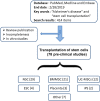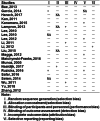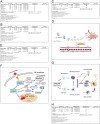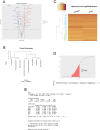Transplantation of bone marrow mesenchymal stem cells improves cognitive deficits and alleviates neuropathology in animal models of Alzheimer's disease: a meta-analytic review on potential mechanisms
- PMID: 32460886
- PMCID: PMC7251864
- DOI: 10.1186/s40035-020-00199-x
Transplantation of bone marrow mesenchymal stem cells improves cognitive deficits and alleviates neuropathology in animal models of Alzheimer's disease: a meta-analytic review on potential mechanisms
Abstract
Background: Alzheimer's disease is a neurodegenerative disorder. Therapeutically, a transplantation of bone marrow mesenchymal stem cells (BMMSCs) can play a beneficial role in animal models of Alzheimer's disease. However, the relevant mechanism remains to be fully elucidated.
Main body: Subsequent to the transplantation of BMMSCs, memory loss and cognitive impairment were significantly improved in animal models with Alzheimer's disease (AD). Potential mechanisms involved neurogenesis, apoptosis, angiogenesis, inflammation, immunomodulation, etc. The above mechanisms might play different roles at certain stages. It was revealed that the transplantation of BMMSCs could alter some gene levels. Moreover, the differential expression of representative genes was responsible for neuropathological phenotypes in Alzheimer's disease, which could be used to construct gene-specific patterns.
Conclusions: Multiple signal pathways involve therapeutic mechanisms by which the transplantation of BMMSCs improves cognitive and behavioral deficits in AD models. Gene expression profile can be utilized to establish statistical regression model for the evaluation of therapeutic effect. The transplantation of autologous BMMSCs maybe a prospective therapy for patients with Alzheimer's disease.
Keywords: Alzheimer’s disease; Amyloid β peptide; Animal model; Bone marrow mesenchymal stem cells; Cognitive deficits; Memory loss; Meta-analysis; Neuropathology.
Conflict of interest statement
The authors have nothing to disclose.
Figures





Similar articles
-
The functional mechanism of bone marrow-derived mesenchymal stem cells in the treatment of animal models with Alzheimer's disease: crosstalk between autophagy and apoptosis.Stem Cell Res Ther. 2022 Mar 3;13(1):90. doi: 10.1186/s13287-022-02765-8. Stem Cell Res Ther. 2022. PMID: 35241159 Free PMC article. Review.
-
Cerebrospinal Fluid (CSF) Exchange Therapy with Artificial CSF Enriched with Mesenchymal Stem Cell Secretions Ameliorates Cognitive Deficits and Brain Pathology in Alzheimer's Disease Mice.J Alzheimers Dis. 2020;76(1):369-385. doi: 10.3233/JAD-191219. J Alzheimers Dis. 2020. PMID: 32474465
-
Effects of mesenchymal stem cells transplantation on cognitive deficits in animal models of Alzheimer's disease: A systematic review and meta-analysis.Brain Behav. 2018 Jul;8(7):e00982. doi: 10.1002/brb3.982. Epub 2018 Jun 6. Brain Behav. 2018. PMID: 29877067 Free PMC article.
-
Intravenous transplantation of bone marrow-derived mononuclear cells prevents memory impairment in transgenic mouse models of Alzheimer's disease.Brain Res. 2015 Apr 24;1605:49-58. doi: 10.1016/j.brainres.2015.02.011. Epub 2015 Feb 16. Brain Res. 2015. PMID: 25698614
-
Functional Mechanism of Bone Marrow-Derived Mesenchymal Stem Cells in the Treatment of Animal Models with Alzheimer's Disease: Inhibition of Neuroinflammation.J Inflamm Res. 2021 Sep 17;14:4761-4775. doi: 10.2147/JIR.S327538. eCollection 2021. J Inflamm Res. 2021. PMID: 34566422 Free PMC article. Review.
Cited by
-
CX3CL1 Derived from Bone Marrow Mesenchymal Stem Cells Inhibits Aβ 1-42-Induced SH-SY5Y Cell Pathological Damage through TXNIP/NLRP3 Signaling Pathway.Comput Math Methods Med. 2022 Sep 8;2022:1949344. doi: 10.1155/2022/1949344. eCollection 2022. Comput Math Methods Med. 2022. Retraction in: Comput Math Methods Med. 2023 Jun 28;2023:9817614. doi: 10.1155/2023/9817614. PMID: 36118839 Free PMC article. Retracted.
-
Advances in stromal cell therapy for management of Alzheimer's disease.Front Pharmacol. 2022 Oct 4;13:955401. doi: 10.3389/fphar.2022.955401. eCollection 2022. Front Pharmacol. 2022. PMID: 36267273 Free PMC article. Review.
-
Current state of stem cell research in non-human primates: an overview.Med Rev (2021). 2023 Nov 6;3(4):277-304. doi: 10.1515/mr-2023-0035. eCollection 2023 Aug. Med Rev (2021). 2023. PMID: 38235400 Free PMC article. Review.
-
Crosstalk between bone and brain in Alzheimer's disease: Mechanisms, applications, and perspectives.Alzheimers Dement. 2024 Aug;20(8):5720-5739. doi: 10.1002/alz.13864. Epub 2024 Jun 2. Alzheimers Dement. 2024. PMID: 38824621 Free PMC article. Review.
-
Resveratrol Enhances the Efficacy of Combined BM-MSCs Therapy for Rat Spinal Cord Injury via Modulation of the Sirt-1/NF-κB Signaling Pathway.Neurochem Res. 2024 Nov 16;50(1):12. doi: 10.1007/s11064-024-04264-z. Neurochem Res. 2024. PMID: 39549125
References
-
- Querfurth HW, LaFerla FM. Alzheimer's disease. N Engl J Med. 2010;362(4):329–344. - PubMed
-
- Matchynski-Franks JJ, Pappas C, Rossignol J, Reinke T, Fink K, Crane A, et al. Mesenchymal stem cells as treatment for behavioral deficits and neuropathology in the 5xFAD mouse model of Alzheimer's disease. Cell Transplant. 2016;25(4):687–703. - PubMed
-
- Lee JK, Jin HK, Endo S, Schuchman EH, Carter JE, Bae JS. Intracerebral transplantation of bone marrow-derived mesenchymal stem cells reduces amyloid-beta deposition and rescues memory deficits in Alzheimer's disease mice by modulation of immune responses. Stem Cells. 2010;28(2):329–343. - PubMed
-
- Verma S, Kumar A, Tripathi T, Kumar A. Muscarinic and nicotinic acetylcholine receptor agonists: current scenario in Alzheimer's disease therapy. J Pharm Pharmacol. 2018;70(8):985–993. - PubMed
Publication types
MeSH terms
Grants and funding
LinkOut - more resources
Full Text Sources
Medical

